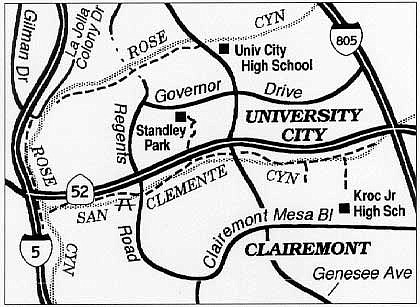 Facebook
Facebook
 X
X
 Instagram
Instagram
 TikTok
TikTok
 Youtube
Youtube
Eastbound in the right lane of Highway 52, the San Clemente Canyon Freeway, you can look down upon a long, slender, almost unbroken swath of natural vegetation: massive sycamores, stately live oaks, climbing vines, and tangled shrubs. The freeway was built in the early '70s higher up on the slope of the canyon in an effort to spare most of the trees -- appropriately so in view of the fact that such riparian, or stream-loving, vegetation covers less than 0.2 percent of San Diego County's land area.
Much of San Clemente Canyon and several of its steep finger canyons are included within the boundaries of Marian Bear Park, an area administered by the city of San Diego as natural open space. Facilities include parking areas, picnic tables and restrooms off Regents Road and Genesee Avenue, and a few benches scattered elsewhere. What you won't often find here is silence, though early Sunday morning is a good bet if you'd rather hear bird songs and not much freeway traffic.
The main hiking and mountain-biking pathway in the canyon stretches for three miles along the seasonal (now virtually dry) stream. The east end of the park, near I-805, offers the prettiest vegetation, the densest shade, and the biggest infestations of poison oak. The latter's vines drape across tree trunks and limbs like lacy curtains and sometimes spread laterally on the side of the trail.
Several back entrances into Marian Bear Park and San Clemente Canyon can be found. Mountain bikers frequently make use of a connection between San Clemente Canyon and a paved bike path paralleling Interstate 5 under Highway 52. From a point on the main trail between Regents Road and Genesee Avenue, a 0.5-mile-long trail goes north under Highway 52, follows a sage-scented ravine, zigzags through a grove of eucalyptus, and emerges at Standley Park in University City. On the south side of San Clemente Canyon, an obscure pathway goes up to Cobb Drive on the mesa above. Another eroded path follows high-voltage power lines up toward Kroc Junior High School.


Eastbound in the right lane of Highway 52, the San Clemente Canyon Freeway, you can look down upon a long, slender, almost unbroken swath of natural vegetation: massive sycamores, stately live oaks, climbing vines, and tangled shrubs. The freeway was built in the early '70s higher up on the slope of the canyon in an effort to spare most of the trees -- appropriately so in view of the fact that such riparian, or stream-loving, vegetation covers less than 0.2 percent of San Diego County's land area.
Much of San Clemente Canyon and several of its steep finger canyons are included within the boundaries of Marian Bear Park, an area administered by the city of San Diego as natural open space. Facilities include parking areas, picnic tables and restrooms off Regents Road and Genesee Avenue, and a few benches scattered elsewhere. What you won't often find here is silence, though early Sunday morning is a good bet if you'd rather hear bird songs and not much freeway traffic.
The main hiking and mountain-biking pathway in the canyon stretches for three miles along the seasonal (now virtually dry) stream. The east end of the park, near I-805, offers the prettiest vegetation, the densest shade, and the biggest infestations of poison oak. The latter's vines drape across tree trunks and limbs like lacy curtains and sometimes spread laterally on the side of the trail.
Several back entrances into Marian Bear Park and San Clemente Canyon can be found. Mountain bikers frequently make use of a connection between San Clemente Canyon and a paved bike path paralleling Interstate 5 under Highway 52. From a point on the main trail between Regents Road and Genesee Avenue, a 0.5-mile-long trail goes north under Highway 52, follows a sage-scented ravine, zigzags through a grove of eucalyptus, and emerges at Standley Park in University City. On the south side of San Clemente Canyon, an obscure pathway goes up to Cobb Drive on the mesa above. Another eroded path follows high-voltage power lines up toward Kroc Junior High School.
